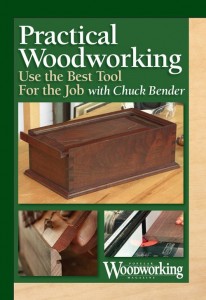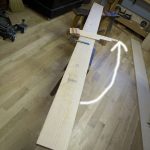We may receive a commission when you use our affiliate links. However, this does not impact our recommendations.
 As the “new guy” on the Popular Woodworking Magazine team (and you may, or may not, know there’s an even newer guy on the team now – Mike Wallace…no, not that Mike Wallace, but more from and about him later) I was asked to record a video that illustrates my woodworking philosophy. Being a period furnituremaker that tried to produce in appearance accurate reproductions of pieces made in this country during the 18th century while trying to make a living doing it doesn’t mean I didn’t try to work efficiently.
As the “new guy” on the Popular Woodworking Magazine team (and you may, or may not, know there’s an even newer guy on the team now – Mike Wallace…no, not that Mike Wallace, but more from and about him later) I was asked to record a video that illustrates my woodworking philosophy. Being a period furnituremaker that tried to produce in appearance accurate reproductions of pieces made in this country during the 18th century while trying to make a living doing it doesn’t mean I didn’t try to work efficiently.
In many ways, the fact that I was trying to earn a living from making furniture meant that I was forced to use the most efficient methods at my disposal. The hard part for for any woodworker is determining what that “best” method is and when to employ it.
For me, it all goes back to my beginnings as a woodworker. My teacher, Werner Duerr, taught his vocational program similar to his own apprenticeship in Germany. We learned about wood and its structure then we jumped into sharpening, maintaining and using hand tools because they are the easiest to see how the wood reacts to the application of a tool. If you’ve ever picked up a hand plane and used it in the wrong direction on a board, you know exactly what I mean.
It’s that ingrained knowledge of the medium that Werner was trying to teach us. Once you understand wood choosing the most efficient method for working it becomes a lot easier. Sure, I know (and when I say “know” I mean at an instinctual level) how to plane a board flat and to thickness with a hand plane, but the fact that I can run it through a planer in one tenth the time saves me that one, irreplaceable commodity that seems to be in short supply for most people – time.
This might sound in opposition to my idea of making pieces that look like they were made completely by hand 250 years ago, but it isn’t. I use the power tools to do my grunt work and finish everything by hand. If the last surface left by a tool is one that I wield in my hands that leaves the same marks as the maker of the original I’m copying, what difference does it make how I got rid of all the waste material up to that point?
Have I made pieces without the aid of power tools? Sure, but the time-value of the pieces was such that even the vast majority of my customers wouldn’t have been able to buy them. For the amateur woodworker, I see a time-value to the pieces you make too. You need to work efficiently and effectively because I’ve never heard one of you complain about having too much time to spend in the shop.
I’m not knocking pieces made entirely by hand. If you don’t have space for heavy equipment or you just derive pleasure from making plane shavings (or you have customers willing to pay for your time) then doing things entirely by hand is the way to go. But, if you have limited amounts of time to work in your shop (and you have the space and are willing to commit the financial resources to a well equipped blended shop) then you might consider adding some stationary power tools to your arsenal.
Werner told all of his students to do as much of the work with power tools as they could until the only way to do it better is to do it by hand. I’ve spent my entire career deciding which tasks are “best” done by hand and which are not. That choice, for me, has always been driven by the work and my intent as an artisan. Even when the money wasn’t always there to justify doing things a certain way, I often chose a less efficient method to maintain a certain level of integrity with my work. But that choice was mine to make and your choice may differ. That’s the whole point of developing a woodworking philosophy – it helps guide you and open opportunities for you that you might otherwise overlook if you lacked one.
We live in a tremendous time to be a woodworker and we have more options open to us than at any time in human history. Why not use all of the tools available to us rather than exclude one type or another based on whether they burn electrons or not? Keeping all the options open gives us a wider variety of choices on how to do things and why. I’ve always found having more choices at my disposal is better than fewer.
To get a little more acquainted with my philosophy, check out my new DVD “Practical Woodworking” at shopwoodworking.com
Here are some supplies and tools we find essential in our everyday work around the shop. We may receive a commission from sales referred by our links; however, we have carefully selected these products for their usefulness and quality.









As always, your entry makes me think about why I do things in a given way. Chris Schwarz made a comment a while back that resonated with me, and you have said much the same thing here. Doing woodworking for the fun of the process, I pick the power tools that remove the tedium from task. Long rips ith a handsaw are just boring work. The bandsaw does that job much better. I find less and less that I need boards with two faces parallel (I’m not too old to lean new stuff,) but if I do, I can save the cost of the 18″ joiner with some basic hand planes, done to 60% flat, then finish with my planner.
I often find that my philosophy and my wallet are at odds with each other. (especially when it comes to tools) 😉